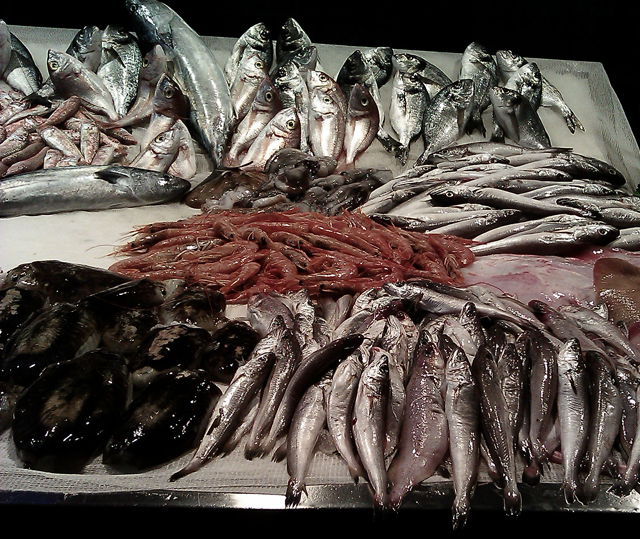 “What are you doing?” shouts the old man at the fish market. “You’re painting the fish black! It’s a Mussolini fish!” Lucia, half-laughing and half-horrified, tries to quiet him down, but he’s having none of it.
“What are you doing?” shouts the old man at the fish market. “You’re painting the fish black! It’s a Mussolini fish!” Lucia, half-laughing and half-horrified, tries to quiet him down, but he’s having none of it.
It’s about 9am and we’re at La Pescheria in Catania. We’ve been here since just after 7, which is a time of the morning that I don’t often see nowadays. It’s been worth it, though. We’ve come to watch Victòria Rabal work on the Catania leg of her latest project, Gyotaku: Capturing the Spirit of Fish. Victòria is a Spanish artist based in Barcelona, which is where this project started.
No, wait – it started much longer ago and far further away than that.
Gyotaku is a Japanese word that means ‘fish rubbing’ and it originated in the traditional fish markets of Japan. Stallholders at the markets would cover the fish with soluble ink and press paper onto them to create a transfer. They would then put the resulting picture up on the wall, along with the price.
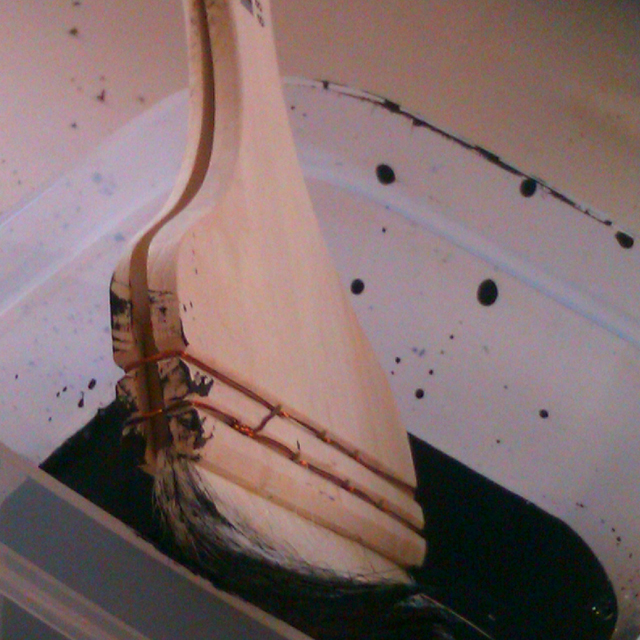 Out of practicality comes beauty. Victòria isn’t a fish seller. She’s an artist. One of her missions with this project is to ‘bring the fish back into the light’, so we spend a good amount of time walking around the market talking to the fish sellers, trying to find the perfect specimen. There are plenty to choose from. La Pescheria runs every morning and is full of vendors hawking their wares. When we arrived at 7, most of them were just setting up, but by 8 they’re in full flow. Lucia and I wander around in Victòria’s wake, asking questions of the stallholders. Lucia points at some squid-like fish. “What are these?” The man looks at her with a patient smile. “Er – squid, signora.” Lucia bursts into raucous laughter. “Of course they are! I’m so sorry!” It seems I’m not the only one who’s a bit fuzzy-headed at this hour.
Out of practicality comes beauty. Victòria isn’t a fish seller. She’s an artist. One of her missions with this project is to ‘bring the fish back into the light’, so we spend a good amount of time walking around the market talking to the fish sellers, trying to find the perfect specimen. There are plenty to choose from. La Pescheria runs every morning and is full of vendors hawking their wares. When we arrived at 7, most of them were just setting up, but by 8 they’re in full flow. Lucia and I wander around in Victòria’s wake, asking questions of the stallholders. Lucia points at some squid-like fish. “What are these?” The man looks at her with a patient smile. “Er – squid, signora.” Lucia bursts into raucous laughter. “Of course they are! I’m so sorry!” It seems I’m not the only one who’s a bit fuzzy-headed at this hour.
Victòria has chosen her fish – a large capone, the length of my arm. Her son, Xavier, looks on a bit nervously. “We have to eat that later. I don’t know how we’ll get through it …” When I see him the next day he confesses that they gave it away to a beggar woman. A gentle smile spreads across his face as he tells me. “She seemed happy.”
We go past a stall that’s selling live fish. Most are stored in large blue buckets of water under the stall, with a few being put into polystyrene boxes on top for display purposes. I peer into one of the buckets: it’s full of fat, langoustine-type crustaceans. A bucket one along contains eels, insinuating themselves smoothly, liquidly, endlessly around one other. The stallholder fishes some out to put on the display, but drops one. It slides, fast, across the cobbles as the stallholder chases after it, making ineffectual grabs as it slithers out of his hands time and again. I teach Lucia and Xavier the English idiom ‘slippery as an eel’ and Lucia tells me that there’s a stallholder who fishes freshwater ones straight out from a grate in the middle of the market.
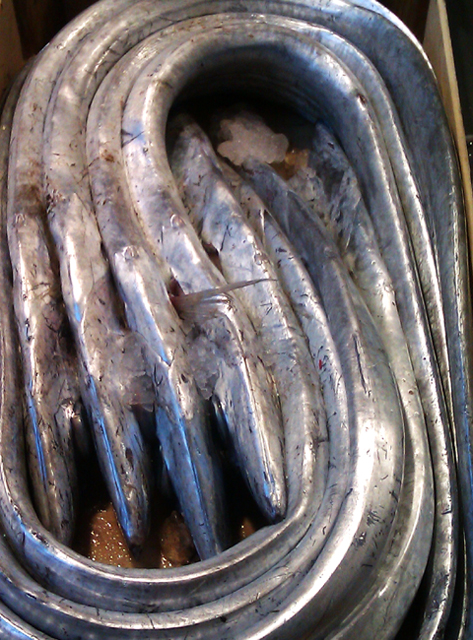 La Pescheria sits over the top of the river Amenano which runs through Catania. It mostly hides itself underground, but it can be seen at la pescheria as it runs under la Fontana dell’Amenano, and also in the lava tunnel under Ostello. One night last winter, we teachers went to Ostello and sat on cold, damp stone in the lava cave drinking cocktails and enjoying the sound of the river. Tom’s curiosity (and drunkenness) got the better of him and he took off his shoes and socks and paddled up the river into the gloom. He was gone for five minutes before coming back, thoroughly spooked. “It’s dark in there!”
La Pescheria sits over the top of the river Amenano which runs through Catania. It mostly hides itself underground, but it can be seen at la pescheria as it runs under la Fontana dell’Amenano, and also in the lava tunnel under Ostello. One night last winter, we teachers went to Ostello and sat on cold, damp stone in the lava cave drinking cocktails and enjoying the sound of the river. Tom’s curiosity (and drunkenness) got the better of him and he took off his shoes and socks and paddled up the river into the gloom. He was gone for five minutes before coming back, thoroughly spooked. “It’s dark in there!”
Lucia tells me that in years gone by, when Ostello used to do music nights with paid entrance fees, people would enter the river at the fountain and wade through the tunnel to Ostello to avoid paying. We both shiver claustrophobically at the thought, but the little devil at the back of my mind wants to try it anyway. The same devil that tells me to climb narrow stairwells or go down mine shafts and then runs screaming when he can feel the walls closing in around him, leaving me fighting for breath and light-headed with panic.
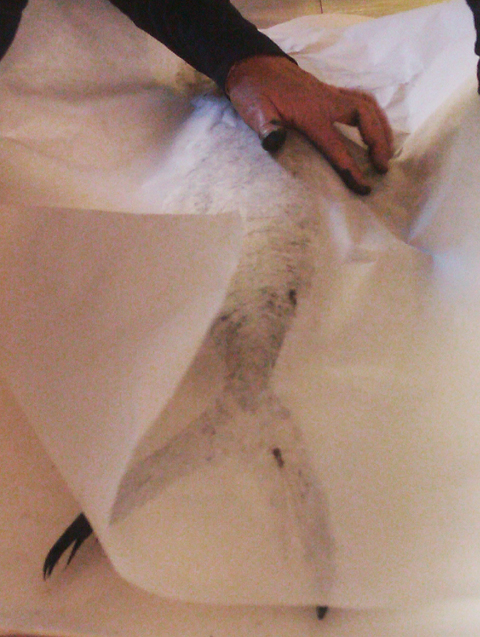 Victòria has found a corner of the market with a friendly stallholder who can lend her a table to work on. She lays out her materials: ink; brushes; giant fish. Behind her she puts an A3 portfolio and a cardboard tube. These contain the paper that she uses to create the transfers. The paper in the portfolio is standard stuff for test prints, but the paper in the cardboard tube she makes herself. It’s light and tissue-like so the breeze wafting through the market this morning doesn’t make our lives easy. At one point, Xavier, Lucia and I all three are trying to keep a piece of paper, eight foot long and covered in wet ink, under control. We don’t entirely manage it. It’s just as well the ink washes off easily.
Victòria has found a corner of the market with a friendly stallholder who can lend her a table to work on. She lays out her materials: ink; brushes; giant fish. Behind her she puts an A3 portfolio and a cardboard tube. These contain the paper that she uses to create the transfers. The paper in the portfolio is standard stuff for test prints, but the paper in the cardboard tube she makes herself. It’s light and tissue-like so the breeze wafting through the market this morning doesn’t make our lives easy. At one point, Xavier, Lucia and I all three are trying to keep a piece of paper, eight foot long and covered in wet ink, under control. We don’t entirely manage it. It’s just as well the ink washes off easily.
Victòria’s having problems. Again the breeze coming through the market is making life difficult: the ink’s drying too quickly so she can’t get a good transfer. We’ve gathered a crowd and she’s tight-lipped at not being able to get the results she envisioned. She sends Xavier off to get water.
Lucia and I hang on to the tissue paper, marvelling over the details. It may not be exactly what Victòria was after, but it’s still beautiful: the paper and ink capture the scales and undulations of the fish’s flesh, even down to its scars. The bit she’s having difficulties with is the dorsal fin, which she has to hold out from the fish’s spine as she paints it, then maneoevre the delicate paper over the top of it and press it onto the fin without either ripping it on the fierce-looking spikes, or letting the fin retract. More hands than two are needed. Lucia steps in, hovering paper over the top of the fish ready to drop as soon as the ink is on. Victòria presses the paper onto the ink and peels it back. She smiles: she’s got the print she wanted and the fish lives once more.
Victòria’s work can be seen in Catania until 9 January 2013 at the Carte D’Arte exhibition at Piazza Manganelli, 16.

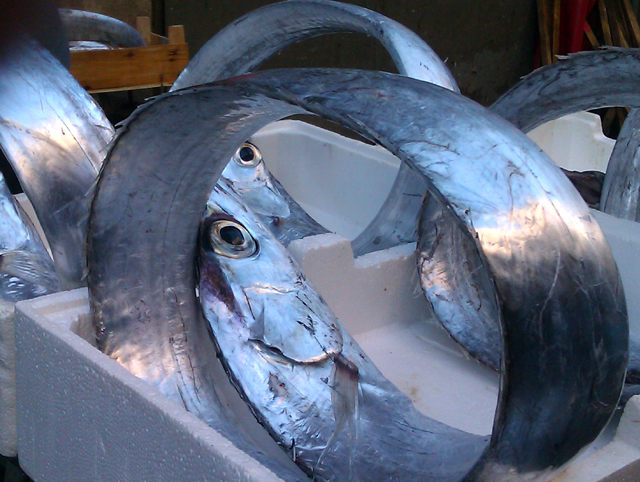






Pingback: Quasi Siciliana » Bolo-Rei (Portuguese Epiphany Cake)
Pingback: Quasi Siciliana | Inky, spicy cuttlefish salad